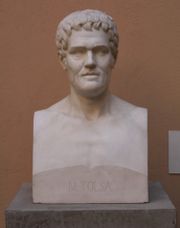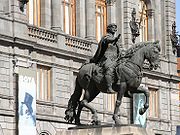
Manuel Tolsá
Encyclopedia

, May 4, 1757—Mexico City
Mexico City
Mexico City is the Federal District , capital of Mexico and seat of the federal powers of the Mexican Union. It is a federal entity within Mexico which is not part of any one of the 31 Mexican states but belongs to the federation as a whole...
, December 24, 1816) was a prolific Neoclassical
Neoclassicism
Neoclassicism is the name given to Western movements in the decorative and visual arts, literature, theatre, music, and architecture that draw inspiration from the "classical" art and culture of Ancient Greece or Ancient Rome...
architect
Architect
An architect is a person trained in the planning, design and oversight of the construction of buildings. To practice architecture means to offer or render services in connection with the design and construction of a building, or group of buildings and the space within the site surrounding the...
and sculptor in Spain and Mexico.
Biography
Tolsá studied at the Royal Academy of San Carlos in Valencia and the Royal Academy of San Fernando in MadridMadrid
Madrid is the capital and largest city of Spain. The population of the city is roughly 3.3 million and the entire population of the Madrid metropolitan area is calculated to be 6.271 million. It is the third largest city in the European Union, after London and Berlin, and its metropolitan...
. He was a student of José Puchol in sculpture and of Ribelles, Gascó and Gilabert in architecture. In Spain he was the sculptor of the king's chamber, minister of the Supreme Junta of Commerce, Minting and Mines, and an academic in San Fernando. In 1790 he was named director of sculpture at the recently created Academy of San Carlos
Academy of San Carlos
The Academy of San Carlos is located at 22 Academia Street in just northeast of the main plaza of Mexico City. It was the first major art academy and the first art museum in the Americas. It was founded in 1781 as the School of Engraving and moved to the Academia Street location about 10 years later...
in Mexico City. He sailed from Cádiz
Cádiz
Cadiz is a city and port in southwestern Spain. It is the capital of the homonymous province, one of eight which make up the autonomous community of Andalusia....
in February, 1791, bringing with him to New Spain
New Spain
New Spain, formally called the Viceroyalty of New Spain , was a viceroyalty of the Spanish colonial empire, comprising primarily territories in what was known then as 'América Septentrional' or North America. Its capital was Mexico City, formerly Tenochtitlan, capital of the Aztec Empire...
, in accordance with the king's instructions, books, instruments of his profession, and plaster copies of classic sculptures from the Vatican Museum. He married María Luisa de Sanz Téllez Girón y Espinosa in the port of Veracruz
Veracruz
Veracruz, formally Veracruz de Ignacio de la Llave officially Estado Libre y Soberano de Veracruz de Ignacio de la Llave , is one of the 31 states that, along with the Federal District, comprise the 32 federative entities of Mexico. It is divided in 212 municipalities and its capital city is...
.
On his arrival in Mexico City the ayuntamiento (city government) made him supervisor of the drainage and water supply systems of the city and assigned him the tasks of the replanting the Alameda park in the center of the city and the grounds of the coliseum. For these services he did not receive compensation. Thereafter he dedicated himself to the artistic and civil works for which he is now remembered. He also built furniture, made adornments for altars (candelabra, crucifixes, etc.), cast cannons, opened a bathhouse, built coaches and established a kiln. He donated a collection of molds and figures and 300 medals and coins to the Academy of San Carlos.
Tolsá died in 1816 of a gastric ulcer. His remains were interred in the church of Santa Veracruz, and later transferred to San Fernando.
Tolsá's works in Mexico
- Conclusion of the work on the Cathedral of Mexico City, including statuary (cupola and facade). This was finished in 1813.
- The Palacio de Minería, Mexico City (1797-1813)


- Equestrian statue of Charles IVEquestrian statue of Charles IVThe equestrian statue of Charles IV is a bronze sculpture cast by Manuel Tolsá on August 4, 1802 in Mexico City, Mexico in honour of Charles IV. This statue has been displayed in different points of the city and is considered one of the finest achievements of Mr. Tolsá...
("El Caballito") (1796-1803; cast on August 4, 1802). Alexander von HumboldtAlexander von HumboldtFriedrich Wilhelm Heinrich Alexander Freiherr von Humboldt was a German naturalist and explorer, and the younger brother of the Prussian minister, philosopher and linguist Wilhelm von Humboldt...
wrote of this statue, "M. Tolsa, professor of sculpture at Mexico, was even able to cast an equestrian statue of King Charles the Fourth; a work which, with the exception of the Marcus Aurelius at Rome, surpasses in beauty and purity of style everything which remains in this way in Europe."http://www.fordham.edu/halsall/mod/1800humboldt-mexico.html
- The old palace of Buenavista (today the Museum of San Carlos)
- The palace of the marqués del Apartado, in front of the Templo Mayor, Mexico City (1810). This is where King Ferdinand VII would have stayed if he had arrived in Mexico.
- Main altar principal of the Cathedral of PueblaPueblaPuebla officially Estado Libre y Soberano de Puebla is one of the 31 states which, with the Federal District, comprise the 32 Federal Entities of Mexico. It is divided in 217 municipalities and its capital city is Puebla....
and an extant statue of the Virgin in wood, also at Puebla
- Main altar of the church of Santo Domingo
- Main altar of the church of La Profesa. The face of the Virgin seen on the right was apparently modeled on that of "La Güera" Rodríguez (María Ignacia Rodríguez de Velasco y Osorio BarbaMaría Ignacia Rodríguez de Velasco y Osorio BarbaMaría Ignacia Javiera Rafaela Agustina Feliciana Rodríguez de Velasco y Osorio Barba Jimenez Bello De Pereyra Hernandez de Cordoba Salas Solano Garfias, known as la Güera Rodríguez was a Criolla figure in the society of Mexico City, and a proponent of Mexican independence from Spain.Through the...
).
- Altar "La Purísima Concepción" in the church of La ProfesaTemple of San Felipe Neri "La Profesa"The Temple of San Felipe Neri, commonly known as "La Profesa" , is a Roman Catholic parish church that was established by the Society of Jesus late in the 16th century as the church of a community of professed Jesuits...
- Main altar of the Carmelite convent dedicated to San Felipe de Jesús (not extant)
- The fountain at the beginning of the Camino Real to TolucaTolucaToluca, formally known as Toluca de Lerdo, is the state capital of Mexico State as well as the seat of the Municipality of Toluca. It is the center of a rapidly growing urban area, now the fifth largest in Mexico. It is located west-southwest of Mexico City and only about 40 minutes by car to the...
— an obelisk and a pyramid (not extant)
- Bust of for the tomb of Hernán CortésHernán CortésHernán Cortés de Monroy y Pizarro, 1st Marquis of the Valley of Oaxaca was a Spanish Conquistador who led an expedition that caused the fall of the Aztec Empire and brought large portions of mainland Mexico under the rule of the King of Castile in the early 16th century...
, in the Hospital de Jesús
- Bronze statues of Jesus in the Cathedral of MoreliaMoreliaMorelia is a city and municipality in the north central part of the state of Michoacán in central Mexico. The city is in the Guayangareo Valley and is the capital of the state. The main pre-Hispanic cultures here were the P'urhépecha and the Matlatzinca, but no major cities were founded in the...
- Design of the Neoclassical part of the Church of Loreto
- Plans of the Hospicio CabañasHospicio CabañasThe Hospicio Cabañas in Guadalajara, Jalisco, Mexico, a World Heritage Site, is one of the oldest and largest hospital complexes in Spanish America....
in GuadalajaraGuadalajara, JaliscoGuadalajara is the capital of the Mexican state of Jalisco, and the seat of the municipality of Guadalajara. The city is located in the central region of Jalisco in the western-pacific area of Mexico. With a population of 1,564,514 it is Mexico's second most populous municipality...
- Plans of the convent of the Propaganda Fide in OrizabaOrizabaOrizaba is a city and municipality in the Mexican state of Veracruz. It is located 20 km west of its sister city Córdoba, and is adjacent to Río Blanco and Ixtaczoquitlán, on Federal Highways 180 and 190. The city had a 2005 census population of 117,273 and is almost coextensive with its small...
- Unrealized projects for a bull ring, the palace of the governor of DurangoDurangoDurango officially Estado Libre y Soberano de Durango is one of the 31 states which, with the Federal District, comprise the 32 Federal Entities of Mexico. The state is located in Northwest Mexico. With a population of 1,632,934, it has Mexico's second-lowest population density, after Baja...
, a cemetery, a convent, etc.
- Celda de la Marquesa de Selva Nevada in the Ex convento de Regina Porta Coeli. Now is the Celda Contemporánea in to Universidad del Claustro de Sor JuanaUniversidad del Claustro de Sor JuanaThe University of the Cloister of Sor Juana is a private university located in the former San Jerónimo Convent in the historic center of Mexico City. This convent is best known for having been the home of Sor Juana Inés de la Cruz for over twenty five years, she produced many of her writings here...
(Cloister of Sor Juana University) in Mexico CityMexico CityMexico City is the Federal District , capital of Mexico and seat of the federal powers of the Mexican Union. It is a federal entity within Mexico which is not part of any one of the 31 Mexican states but belongs to the federation as a whole...
.


